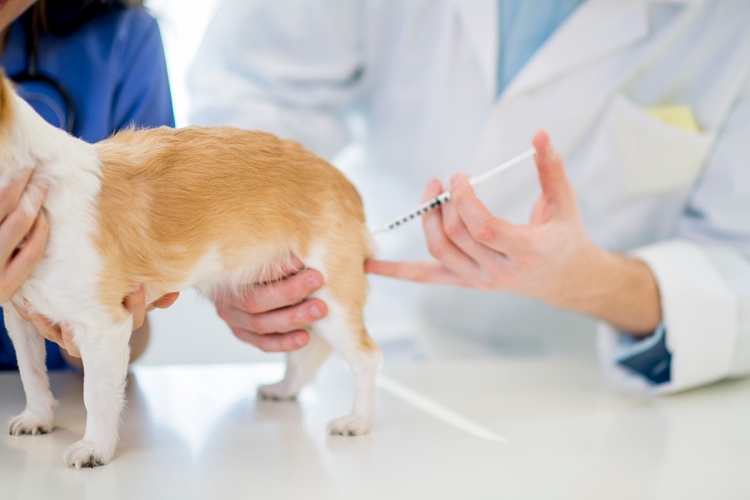Be sure your pet is current on all vaccines and carry proof, especially for rabies.

Photo courtesy www.sddac.com/content/sdc/das/adopt/rabies.html
By Dr. Jeanne Haggerty-Arcay

Dr. Jeanne Haggerty-Arcay
With COVID-19 continuing to loom over us, many Morgan Hill residents are opting out of air travel this summer and choosing to travel on the road. RV rentals and purchases have skyrocketed and car travel to Airbnb destinations is ever more popular. This shift in travel has also created a change in how people handle their pets during vacation. Instead of boarding their pets or hiring pet-sitters, many more people are choosing to travel with their pets. But is this the right choice for you and your pet? Here are a few things to consider before you make your decision.
Previous Travel
 Has your pet ever traveled by car? If so, does he or she have any anxiety or motion sickness? If the answer is yes, then you may want to reconsider your decision to bring your pet or at minimum discuss medications with your veterinarian. Pets with travel anxiety or car sickness who travel unmedicated continue in a perpetual cycle. The dog feels poorly when traveling so each time he hops into the car, he becomes even more anxious because he has learned to associate the car with anxiety, nausea or vomiting. Either way, the car is now associated with a bad experience. Medications can help but this needs to be tested at home in advance and there is no “quick fix” to the issue. The day prior to travel is not the time to pick up medication and expect a positive experience.
Has your pet ever traveled by car? If so, does he or she have any anxiety or motion sickness? If the answer is yes, then you may want to reconsider your decision to bring your pet or at minimum discuss medications with your veterinarian. Pets with travel anxiety or car sickness who travel unmedicated continue in a perpetual cycle. The dog feels poorly when traveling so each time he hops into the car, he becomes even more anxious because he has learned to associate the car with anxiety, nausea or vomiting. Either way, the car is now associated with a bad experience. Medications can help but this needs to be tested at home in advance and there is no “quick fix” to the issue. The day prior to travel is not the time to pick up medication and expect a positive experience.
Vaccines
 Be sure your pet is current on all vaccines and carry proof, especially for rabies. Be aware of your destination and other vaccines or precautions that may be needed for travel to that region. For example, there has been a leptospirosis outbreak recently in the San Diego region. Travel there with your dog may require additional precautions or vaccinations.
Be sure your pet is current on all vaccines and carry proof, especially for rabies. Be aware of your destination and other vaccines or precautions that may be needed for travel to that region. For example, there has been a leptospirosis outbreak recently in the San Diego region. Travel there with your dog may require additional precautions or vaccinations.
Fleas
Be sure that your pet is current on flea preventatives. If you are staying somewhere that allows pets, it is likely to also have fleas.
Food
Bring your pets normal food as you may not have access to a store that carries their normal diet. Adding a diet change is not a good idea.
Breaks
Make sure to take adequate breaks to let your pet get out, stretch, drink water and go to the bathroom.
Heat
Be very aware of the ambient temperature. At 80 degrees, the pavement can be 125 degrees, which is already hot for your pet to be walking around on for extended periods. At 85 degrees the car will easily reach 102 in just 10 minutes. Make sure you have functioning air conditioning and plans do not involve unnecessary stops along the way.
Water Destinations
If you plan to bring your pet to a destination with water, such as a beach, lake or pool do not assume they can swim. They need to be supervised to prevent accidental drowning. Lakes prevent the risk for exposure to parasites, algae and other potential dangers. Ingestion of large amounts of ocean water can be dangerous and even fatal. If you plan to boat with your pet, life jackets are available for dogs.
Veterinarian
Find the location for the closest emergency veterinarian to your destination prior to leaving so you have the number readily available if needed.
Traveling with your pet can definitely add a layer of enjoyment. But it also takes extra planning. Do not assume your destination will be fun for your pet. Remember that travel, new places and change can be very stressful for pets. Although you may want to have your pet with you, consider the option of leaving them at home with a pet sitter, friend or other family. Depending on your travel plans and destination, make a thoughtful choice before deciding to bring your pet with you.






